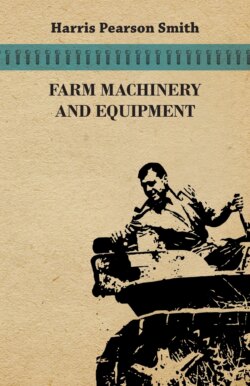Читать книгу Farm Machinery and Equipment - Harris Pearson Smith - Страница 27
На сайте Литреса книга снята с продажи.
GREASES
ОглавлениеThe American Society for Testing Materials defines a petroleum lubri eating grease as “a semisolid or solid combination of a petroleum produc and a soap, or a mixture of soaps, with or without fillers, suitable fo certain types of lubrication.” In ancient times a grease made of anima fat was probably used to lubricate the axles of chariots. Mineral oil grease was developed soon after the discovery of oil in 1859. Early farm ma chinery which was drawn by horses had few moving parts and almost an type of grease would suffice to reduce friction. Modern power-operated machinery has many bearings carrying light to heavy loads. Some parts operate at high speeds and high temperatures and require special high quality greases. A water-repellent grease is required for water pumps; a soda-base grease of spongy or fibrous texture, for wheel bearings and universal joints; a cup grease, for distributor shafts; and a soft tacky grease for chassis joints.
FIG. 5–5. Hydraulic hand-push grease gun and fittings, showing cross section of nozzle and fitting. (Alemite Division, Stewart-Warner Corp.)
Classes of Greases. Greases as indicated above are classed according to the use and application for which they are specially suited. There are many types, but the most common are (1) chassis greases, (2) wheel-bearing greases, (3) water-pump greases, (4) universal-joint greases, and (5) the cup greases. The greases used most are the chassis and the wheel-bearing greases. The chassis grease is designed for pressure-gun application, while the wheel-bearing grease is generally packed in the whee bearing by hand.
FIG. 5–6. Lever-type grease gun.
FIG. 5–7. Portable hand-tank grease guns and pails: A, interchangeable pail pump with hose; B, installing pail pump on pail; C, interchangeable pail pump for gear oils; D, interchangeable pail hand-gun loader; E, detachable lid for hand-gun loader; F, portable grease bucket with pump. (Alemite Division, Stewart-Warner Corp.)
Grades for Greases. The National Lubricating Grease Institute has adapted six grade numbers which are an indication of firmness or hardness of the grease, as shown in Table 5–3. The ASTM worked penetration at 77°F. is shown in relation to the NLGI grade number.
TABLE 5–3. GREASE GRADES AND WORKED PENETRATION
| NLGI no. | ASTM worked penetration |
| 0 | 355–385 |
| 1 | 310–340 |
| 2 | 265–295 |
| 3 | 220–250 |
| 4 | 175–205 |
| 5 | 130–160 |
The penetration test consists of dropping a metal cone, of standard size and weight, into a worked grease at a specified temperature (usually 77°F.), and measuring the penetration of the cone after a specified time interval. The consistency or hardness of greases ranges from No. 0, very soft, to No. 5, a very hard grease. The color of greases varies from light red to pitch black according to the ingredients used.
FIG. 5–8. Centralized lubricating system with inset showing essential parts of a central lubricating system. (Alemite Division, Stewart-Warner Corp.)
Methods of Applying Greases. Some greases are applied by hand with a paddle, swab, or brush, to gears, chains, and wire rope. Slow-moving bearings may be lubricated by placing the grease in cups of the screw-down, spring-loaded, and automatic types.
All well-designed modern farm machinery has high-pressure grease fittings at the points requiring lubrication. The grease is applied through the fitting with high-pressure grease guns (Figs. 5–5 to 5-8). Companies manufacturing lubricants have available lubrication guides showing all the points on the machine requiring lubrication and the kind of oil or grease recommended for each fitting.
